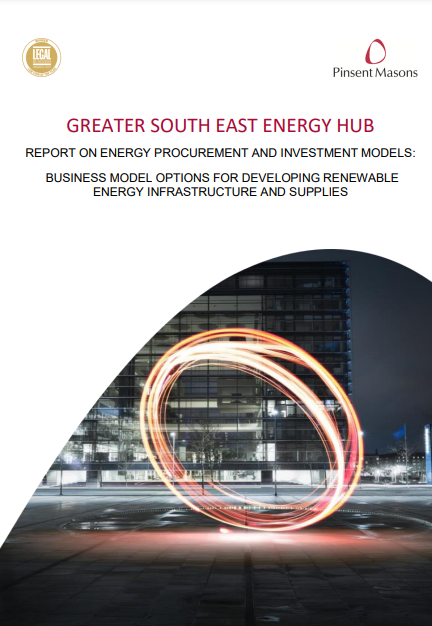This report by Pinsent Masons provides outline legal advice about the different options available to local authorities for clean local energy procurement and infrastructure development.

This report is intended to be read in conjunction with the suite of guidance documents that the Hub has previously prepared or commissioned and does not replace or supersede any such guidance document. Where we are aware of a guidance document prepared by the Hub that already covers an area of relevance to this report we will refer to that guidance document rather than duplicating the information here.
Please note that the report states the current legal position at the time of writing and therefore advice should always be sought from the Hub prior to implementation of a low carbon strategy.
The Government's commitment to Carbon Net-Zero by 2050, with significant changes impacting housing and transport by 2030, means that the UK will need to undergo significant changes in the way communities, use, buy and sell energy in order to meet these changes. At the time of writing this report, the UK is caught in the midst of the Covid-19 Pandemic, which commentators consider will bring with it a potential "market reset", with issues of social value, public sector intervention and green energy at the heart of many policies identified to help kick start or "re-boot" the economy.
In this changing market place, it's clear that local authorities will have a role to play in bringing forward the low-carbon economy on a local and national basis. This is demonstrable in e-mobility where local authorities, alongside the Office of Low Emission Vehicles are investing heavily in public and taxi charging infrastructure . Commentators anticipate that as the UK emerges from Covid-19, that such initiatives will gain greater momentum as the community and behavioural change will see a greater shift in investment in technologies and industries where it sees longer term benefits to society and the environment. This is a good example of how public sector may help bring forward energy infrastructure and supply where there may be, for the time being, less market engagement, but clear longer term benefits and payback.
Report Structure
This report is structured as follows:
Part A outlines each of the key business model options for developing renewable energy infrastructure and energy supplies. This includes:
- (a) local authority delivery;
- (b) delivery via a separate legal entity (wholly owned by the local authority) or in conjunction with the private sector, utilising:
- (i) an Energy Service Company (ESCO)
- (ii) a joint venture arrangement5 ; or
- (iii) a concession arrangement.
- (c) Community Interest Companies and Community Partnerships; and
- (d) sleeved supply of energy.
In relation to each option, our analysis in Part A considers the relevant considerations including in relation to:
- (a) legal structures
- (b) funding and finance
- (c) energy supply
- (d) local authority powers
- (e) procurement and state aid; and
- (f) risks and rewards,
Where appropriate, case studies that illustrate the 'real life' application of the above business model options and considerations. 1.6.3 Part B provides further detail on procurement and state aid considerations.
Part B provides further detail on relevant local authority powers.
Part C provides further detail on electricity licencing considerations.
Appendix 1 provides further detail on legal structures and relevant considerations
The reader should be aware that we make reference to the Public Contracts Regulations 2015, however, depending upon the nature of the energy services which the local authority seeks to undertake, it may be the case that the works and/or services are caught by the Utilities Contract Regulations 2016 if the contract it seeks to undertake is a "utility activity"
Specific advice should be undertaken at the given time to understand the nature of the obligations and relevant procurement rules which apply to the given works and/or services tendered.

